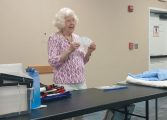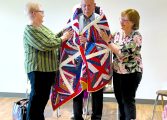Weidenheimer shares his talent with others because he sees a lifelong purpose in it, particularly in addressing the psycho–social needs of society.
“Making art or music are two pastimes that can be enjoyed throughout a long life,” he said. “And they really are much more richly enjoyed as part of a community, rather than all alone painting in your basement, or struggling to learn an instrument in solitary.” He added that this is why he likes teaching workshops and also hosting jamming classes rather than focusing on one– on–one teaching. “The social aspect of painting or playing and singing together is really therapeutic in this age of everyone living semi–solitary lives in separate houses and often only interacting with others via email, Facebook or Twitter. That is especially sad for older people who may find themselves seldom being touched by others in a caring way, physically and emotionally.”
Weidenheimer was introduced to music at the age of eight in Kinsley, Kansas.
“I was pretty typical of so many kids, Parents spend a lot of money on a nice piano, and park it in the living room and a teacher comes by each week to push a kid through the usual beginner books. The piano is a big, hard, impersonal thing and we kids feel really guilty that we’d rather be anywhere other than perched on that bench pounding away,” he said. “Those couple years struggling to try to learn piano, well before I really had any actual interest in music, were simply wasted. My passion for playing didn’t happen until I was about 16, and it was inspired by hearing the first rock n’ roll on the radio and getting my first couple folk music records. A guitar was small and personal compared to a piano. I held it…I didn’t sit at it and I could learn at my own pace in my room with no guilty feelings about leaving a $1,000 piano gathering dust in the living room.”
It was the recordings of Josh White, a blues singer and jazz–inspired guitarist, that inspired Weidenheimer early on. Between about age 15 and 17, he taught himself some basic folk guitar skills from records and then bought his first electric guitar and started copying the early rock groups.
During his first couple years at Menlo College in Menlo Park, California, he joined a rock band as lead guitarist. At about 19, he taught private guitar lessons in music stores in Palo Alto and San Jose. Jerry Garcia also began teaching in those same stores where they became friends and regulars in the San Francisco peninsula party scene.
“Jerry played bass guitar in my band whenever my usual jazz bass player wasn’t available,” Weidenheimer said. “Ron McKernan (Pigpen) and Bill Kreutzman were regulars in my blues band. Both wound up full time with Jerry in the Grateful Dead.”
During his 20s and 30s, he continued teaching guitar and playing professionally, but when he started working as a professional writer with ad agencies in St. Louis he stopped playing music altogether – for nearly 30 years.
“It seems that writing full time took the place of music in my life,” Weidenheimer said. “I didn’t start playing and teaching music again until I retired at about age 60.”
Upon retirement he started teaching adult group classes in guitar in St. Louis. He toured the bluegrass festivals and jam sessions year–round. “What I lacked was any experience as a singer, and a familiarity with all the standard bluegrass and traditional country tunes usually played in the local jams. So in about 2003 I started learning the bluegrass and old–time music repertoire,” he said. “And I also started learning mandolin and then took up fiddle and claw–hammer style banjo. Over the next 10 years I poured many hours a day into learning mandolin and fiddle.”
He and his wife Susan moved to the Lake in 2010 and he continues to jam and teach.
He is a different teacher. He doesn’t give you sheet music and tell you to play chords, he teaches you the theory behind it and in this way you can apply it to any song. He is truly gifted and he shares this with his students,” said music student Maria Carter, who has also attended his art workshops through the Fluvanna Art Association.
As for art, he wasn’t exposed to it until he was a freshman in high school and inspired by a teacher who played “cool jazz” and had lots of books on drawing and painting, particularly on artist Ted Kautzky.
“Of course all kids in the 1950s puddled around with those flip–top Prang watercolor sets, trying to paint on newsprint – which is nearly impossible with watercolor. But I’d never seen what a real artist could do with good paint and brushes on high–grade watercolor paper,” he said. “So I put together a little watercolor set with exactly the same brushes and tube paints and types of watercolor paper he suggested in the book. I spent the next several years studying and repeatedly copying my favorites of his paintings. His books were all the inspiration I needed to begin a lifetime of painting.”
Now he teaches people that studying other artists and copying their work helps the artist to understand the basics and to develop their own style which eventually emerges through study and discipline. Weidenheimer describes the journey of self–discovery by working to overcome weakness and learning about shape, color, lights and darks. He has made an endless study of these elements and has applied the same principles he has learned with music to his love of art.
“Too often beginners are advised that being artistic is a gift – you either are divinely inspired or you aren’t,” he said. “Imagine telling a kid in shop class that all you need to build a dining room table is inspiration. So when our first few paintings fall short we, or our teachers or parents, conclude that we simply don’t have the gift. I read early on that you have to do at least a hundred serious watercolor paintings to develop the basic skills needed to do something worthwhile.
“Think how crazy it is for a grade–school teacher to expect kids to paint realistic trees and houses from their imaginations,” he continued. “The structure of the branches and the layering of the foliage of common trees is incredibly complex. Painting structures like houses or barns requires quite a sophisticated knowledge of perspective principles. It’s a huge challenge for even professional artists to paint realistic looking buildings from imagination. So it’s no surprise the more sensitive kids wind up feeling terribly discouraged when their best efforts depict lollipop trees and goofy–looking houses.”
For the past 60 years Weidenheimer has painted almost daily, primarily in watercolor and oil, still trying to perfect his style. Like his music, he has no formal art school training, but over the years he has taken many week–long workshops with some very fine artists.
“I paint for the satisfaction I get from learning the craft, but have never been interested in entering art shows or marketing my work, although I have done a number of commissions and do sell pieces now and then,” he said. “My greatest pleasure comes from creating and presenting art workshops, and teaching students.”
For anyone interested in Troy Weidenheimer’s music or art classes, contact him at rakun@rakun.com and visit his website at www.rakun.com.




